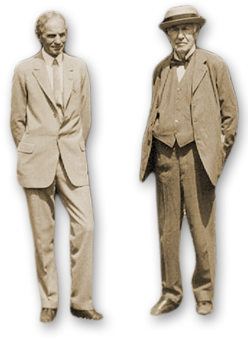A tree of Resiliency and Strength in Edison’s Jungle
May 13, 2024
By Karen M. Maxwell, Horticulture Programs Coordinator and Horticultural Specialist
Most people who visit Edison and Ford Winter Estates are familiar with the story of our iconic Banyan tree, but perhaps not so many are aware that there is another tree that visitors can lay their hands on – perhaps as Edison once did.
Commonly known as blue mahoe (pronounced ma – hoe’ or majo’ azul), the Talipariti elatum or Hibiscus elatus is a tree native to Cuba and Jamaica. Visitors can see this arboreal centenarian along the shoreline of the Caloosahatchee River. Recently, we “sistered” this tree, meaning we planted a juvenile blue mahoe in the shadow of the original to protect our inventory of significantly historical flora.
While mahoe is originally a Carib word, blue refers to the tint of the raw gray wood of this important tree when its lumber is polished – revealing shades of blue, purple and olive green. Today, the durable lumber is rarely exported out of its endemic areas of Cuba or Jamaica and when it is available, only small pieces can be had. The wood is of such fine quality that it is used to make veneers for furniture and musical instruments, so new plantations are being created from Puerto Rico to Mexico.
Another common name is Cuban Bast because the tree’s inner lace-like bark produces a useful fiber historically used to wrap bundles of Cuban cigars. The species is also the national tree of Jamaica and figures prominently in
their art and culture. It is written that mahoe is about as hurricane proof as a tree can be. This salt tolerant tree grows in a variety of soils, and more importantly, it does well from the seashore to high elevations (up to 4,000 feet above sea level) and its quick growth to 60 feet makes it very important in re-forestation efforts in Jamaica.
The blue mahoe is part of the Malvaceae family of plants, which includes cotton and hibiscus and is considered a New World mahoe. In the early 2000s, Dr. Paul Frykell of Texas A&M did some groundbreaking research with the Malvaceae family, whereby he concluded that while all the different species of mahoe trees had flowers that opened yellow and ended their day a distinct shade of crimson – those yellow flowers with a red dot at their base are Old World mahoe and the pure yellow are New World mahoe. He re-classified about 20 hibiscus species into a sub-class known as Talipariti from its original local name of Tali Pariti. Today, both botanical names are accepted as correct.
It is said that in the 1800s, Polynesians introduced an Old World mahoe species (Hibiscus or Talipariti tiliaceus) to Hawaii and taught islanders how to use the tree to make fishing nets and the grass skirts we associate with hula dancers. Today, throughout Hawaii and in Florida, Hibiscus tiliaceus is a Category II invasive species.
The New York Botanical Garden herbarium includes a specimen of the blue mahoe as noted by Thomas Edison’s consulting botanist, Dr. Walter Minton Buswell, originally of New Hampshire. His notes indicate the presence of the tree in 1930 at the Edison home in Fort Myers, but we are not certain when it was planted.
A close cousin of this tree, and a salt tolerant candidate for seaside gardens, is the varigated mahoe (Talipariti tiliaceum ‘tricolor’) which can be found in our Contra Garden along the Marlyn Road entry driveway to the Estates. Grown for its stunning foliage, this tree takes shaping and size control very well, which enables gardeners to create a beautiful specimen tree in their yard. From now until mid-April, give this tree a hard prune to maintain desired height and shape (removing lower branches for instance). A great candidate for full or part sun, if left alone, this great windbreak tree will grow to 25’ tall and about 10’ wide and is loved by butterflies and hummingbirds. The next time it’s flowering, take a look at the flower and see if you can determine if it’s an Old World or New World mahoe.
An invasive mahoe, commonly called seaside mahoe (Thespesia populnea) is often seen along our shores and easily recognized for its cordate (heart) shaped and shiny leaves. In Florida, it’s listed as a Category II invasive by the Florida Invasive Species Council, this tree is one of the most important fast-growing trees in the Pacific Islands. Found throughout the entire tropical region, identified as pantropical, the Popnut is highly valued for its wind-break capacity and its fibrous bark is used to make rope and baskets. No wonder that this tree is invasive in Florida as it is tolerant of poor soils, salt, drought, flooding and light
frost. Its seeds are buoyant, which allows it to travel and re-establish easily on many tropical shorelines.
A fourth mahoe, Hibiscus pernambucensis, (also called seaside mahoe) is arguably native to Florida, though no one is certain when it arrived (native in Florida means something existed here prior to the arrival of the Europeans in 1513). The late great Florida native plant expert and naturalist, Richard (Dick) Workman recorded finding the solid yellow flower of the New World mahoe at J. N. “Ding” Darling National Wildlife Refuge on Sanibel and had his findings verified. If we can locate one, we may want to add it to our collection to pair with our existing New World blue mahoe as we continue to develop the most interesting and historical collection of flora in Southwest Florida.


